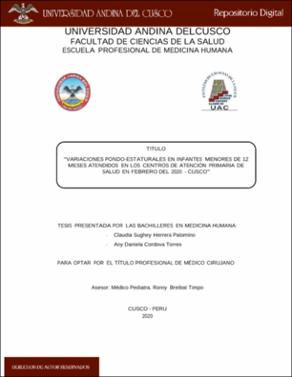| dc.contributor.advisor | Breibat Timpo, Ronny | |
| dc.contributor.author | Herrera Palomino, Claudia Sughey | |
| dc.contributor.author | Cordova Torres, Any Daniela | |
| dc.date.accessioned | 2020-09-15T20:52:15Z | |
| dc.date.available | 2020-09-15T20:52:15Z | |
| dc.date.issued | 2020-05-01 | |
| dc.identifier.uri | https://hdl.handle.net/20.500.12557/3391 | |
| dc.description.abstract | La presente
investigación tiene como objetivo principal identificar
las diferentes
características que se presentan e intervienen en las variaciones de peso y talla de los
infantes menores de 12 meses que son atendidos en centros de salud de atención primaria;
para lo cual se realizó el análisis respectivo de las variables estudiadas como son el sexo, el
peso de nacimiento, el tipo de lactancia y la edad de inicio de alimentación complementaria.
Se trata de una investigación no experimental, descriptivo-analítica, retrospectivotransversal,
cuantitativa en la que participaron 140 infantes atendidos en 3 centros de
atención primaria pertenecientes a la red de EsSalud; obtenemos que el 52.9% de la
población pertenecen al sexo femenino mientras el 47.1% pertenecen al sexo masculino, un
87.9% se ubicaron en un rango adecuado de peso al nacimiento, en segundo lugar los
pacientes macrosómicos con 7.9% y por ultimo un 4.3% presentaron bajo peso al nacer. El
63.3% recibió lactancia materna exclusiva durante los 6 primeros meses, el uso de fórmulas
maternizadas solo fue de un 4.3% en la población general. En cuanto al inicio de la
alimentación complementaria se observó que un 62.1% inicio entre los 4 y 6 meses de vida,
mientras que solo un 2.9% iniciaron la alimentación complementaria a una edad menor a 4
meses. Se encuentra una mayor variación en las curvas de crecimiento de los pacientes
menores de 6 meses
(72.9% de variaciones
)frente a un 27.1% que no varía. Mientras que
en mayores de 6 meses existe una variación del 38.6%. En conclusión, el crecimiento más
importante se da durante los primeros 6 meses de vida, dando así un descenso aceptable
en la velocidad de crecimiento que se relaciona directamente con factores como el tipo de
lactancia durante los 6 primeros meses de vida, y que el crecimiento en mayores de 6 meses
no depende de ningún factor que haya sido estudiado en la presente investigación. | es_PE |
| dc.description.abstract | This research aims to identify the different characteristics that occur and intervene in the
variations in weight and height of infants under 12 months of age who are treated in primary
health care centers; for which the respective analysis of the studied variables was carried out,
such as sex, birth weight, type of breastfeeding and the age of onset of complementary
feeding. This is a descriptive-analytical, cross-sectional, retrospective, quantitative-qualitative
investigation in which 140 infants attended in 3 different primary care centers belonging to
the EsSalud network that met the proposed inclusion criteria participated; After data collection
and analysis, the results were obtained: that 52.9% of the population belong to the female
sex while 47.1% belong to the male sex, 87.9% were in an adequate range of birth weight,
secondly macrosomic patients with 7.9% and finally 4.3% had low birth weight. 63.3%
received exclusive breastfeeding during the first 6 months, the use of infant formulas was only
4.3%
in the general population. As for the start of complementary feeding, a higher
percentage was observed between 4 and 6 months of age, giving a percentage of 62.1%,
while only 2.9% began complementary feeding at an age less than 4 months. A greater
variation is found in the growth curves of patients under 6 months
(72.9% of variations
)
compared to a 27.1% that does not vary. While in over 6 months there is a variation of 38.6%.
In conclusion, we can say that the most important growth occurs during the first 6 months of
life, thus giving an acceptable decrease in the speed of growth that is directly related to factors
such as the type of breastfeeding during the first 6 months of life. and that growth in older
than 6 months does not depend on any factor that has been studied in the present
investigation. | en_US |
| dc.description.uri | Tesis | es_PE |
| dc.format | application/pdf | es_PE |
| dc.language.iso | spa | es_PE |
| dc.publisher | Universidad Andina del Cusco | es_PE |
| dc.rights | info:eu-repo/semantics/openAccess | es_PE |
| dc.rights.uri | https://creativecommons.org/licenses/by-nc-nd/2.5/pe/ | es_PE |
| dc.source | Universidad Andina del Cusco | es_PE |
| dc.source | Repositorio Institucional UAC | es_PE |
| dc.subject | Lactancia materna exclusiva | es_PE |
| dc.subject | Alimentación complementaria | es_PE |
| dc.subject | Crecimiento y desarrollo | es_PE |
| dc.title | Variaciones pondo-estaturales en infantes menores de 12 meses atendidos en los centros de atención primaria de salud en febrero del 2020 - Cusco | es_PE |
| dc.type | info:eu-repo/semantics/bachelorThesis | es_PE |
| thesis.degree.name | Médico Cirujano | es_PE |
| thesis.degree.grantor | Universidad Andina del Cusco. Facultad de Ciencias de la Salud | es_PE |
| thesis.degree.level | Titulo Profesional | es_PE |
| thesis.degree.discipline | Medicina Humana | es_PE |


